Decolonizing STEM Curriculum: Citizen Science and the Lumad STEM Curriculum
By Chuckie Calsado
Volume 23, number 1, Science Under Occupation
The moonlit outlines of a metal gate were only partly visible when our community guide announced that we had reached our destination. After more than five hours of travel in the dead of the night, signage welcomed us with the resolute statement, “This school is a PEACE ZONE. Let us protect it from conflict.”
The sign left us shaken for a brief moment. As three scientist-activists who routinely handle hazards inside and outside our laboratories, we are no strangers to the danger that awaited us in our journey to the center of militarization in the Philippines, where martial law has been declared since May, 2017.1 Nevertheless, the air of threat in our surroundings took hold of us. We shook the feeling off and reminded ourselves of our purpose and the importance of our visit.
Our field visit was the first formal step in the collaborative baseline study on the Lumad community schools’ STEM curriculum. For several years, informal talks on the development of a STEM curriculum for these schools were exchanged between AGHAM (Advocates of Science and Technology for the People), an organization of pro-people science and technology advocates of which the three of us are members, and the Educators’ Development Institute, a non-government program that serves Lumad community schools in the southernmost part of the Philippines. Aside from the documented task of fulfilling a baseline needs assessment, our overall experience was crucial to forming a deeper understanding of the Lumad students’ situation so as to reflect their identity more accurately in the curriculum.
Militarization and the Birth of the “Bakwit School”
For breakfast on our first morning, the students ushered us into their school kitchen. Students were assigned on a daily rotating basis to prepare, cook, and serve food for their classmates, teachers, and visitors. Meals were often prepared using ingredients freshly harvested from their communal school farm.
The Lumad are an agricultural people who heavily depend on the natural environment for their necessities. “Lumad” is a collective term for eighteen tribes of indigenous peoples in Mindanao, the second largest island group in the country.
The Philippine education system has suffered from a lack of funding, leading to overcrowded classrooms, a shortage of materials, and overworked teachers.2 The Lumad people in particular are affected by the underfunding of public services. Schools like the one we were visiting began as a small literacy and numeracy project in the 1990s spearheaded by missionary groups, and later became full-fledged agricultural community schools that cater to different grade levels. With the lack of education services available to them, Lumad community schools became the primary institution to provide education for the Lumad. To date, there are around 215 Lumad community schools across different provinces in Mindanao; however, in 2019, fifty-five Lumad schools were forcibly closed by the government, resulting in the displacement of Lumad students.3
For several centuries, the Lumad’s ancestral lands have been a battleground as bureaucrat-capitalists and imperialists aggressively claim the area for its rich natural resources—minerals, timber and forest lands, and river systems suitable for large dams. Centuries of structural oppression and intrusion on their ancestral lands by military forces, along with local and transnational capitalists who venture on logging, mining, and large-scale agricultural plantations, compelled Lumad communities to arm themselves with pens, paper, and a deeper understanding of their rights as people.4
State military forces and auxiliary units mandated by the government to protect corporate interests are regularly used to sow terror among the Lumad.5 This rampant military harassment normalized the forcible mass evacuations of the Lumad, to the extent that the term bakwit (meaning “evacuate”), became a household term for Lumad among Lumad and non-Lumad people alike. Evacuation centers, collectively run by allied organizations and the Lumad themselves, soon became the norm. Not wanting to forestall the education of their children, Lumad parents sought volunteer teachers from other Lumad tribes and non-Lumad communities, and gathered resources to build makeshift schools, known as Lumad bakwit schools, in the evacuation centers.
Field Notes: Science and Social Issues
The first school we visited has perhaps the most developed campus of all the Lumad community schools; it provides communal demonstration farms for agriculture, wide playing fields, a science lab equipped with old apparatus and equipment, and classrooms with cement walls and floors. However, as in most of the Lumad community schools, electricity is scarce. Classrooms have no fans; only the breeze from open windows kept us cool. Noticing no electrical outlets, we wondered what the classroom would look like once dusk approached.
In one classroom, after initially ignoring our presence, the students approached us with wild curiosity upon learning we were scientists. The seventh-grade children ranged from eleven to fifteen years old. Individual ability, not age, was the primary criterion used to assess grade level. The teacher introduced us as “scientists who can answer your questions.”
“Just tell me the truth: Did we really come from apes? There are stories from the Bible and from our elders, but what’s really true?”
“Why is there day and night?”
“Why is the cardiac pulse the last pulse we have before we die?”
These were just some of the questions that the students threw at us. Their line of questioning not only reflected their curiosity and thirst for learning the science behind various phenomena—it also demonstrated their understanding of the different perspectives and socio-cultural factors influencing the education they receive.6 We were also impressed that the day’s lessons continued to be shared in students’ night-time dormitory chats.
The next school we visited contrasted starkly with our own early school years. Instead of cement multi-story buildings, the school possessed only makeshift rooms with woven bamboo walls and earth floors that each sheltered around twenty students. The scarcity of space and volunteer teachers forced different grade levels to share a single room. In this particular bakwit school, members of the Talaingod Manobo (a Lumad subtribe in the heavily-militarized Pantaron mountain range) sought refuge in the heart of a banana plantation where a farmers’ union welcomed them and cleared space to accommodate the school and temporary homes.7
In one class, fourth- and fifth-grade students sang to the tune of a popular nursery folk song, but the lyrics were changed into a narrative on large-scale logging, mining, and other extractive industries that destroy their ancestral land. The song describes the wanton ecological destruction that results from capitalist greed.
In the third Lumad community school we visited—which also caters to non-Lumad such as Moro (Muslim), Catholics and Bisaya people—one of our colleagues observed what she at first thought was a social science class. The teacher and students were discussing the semi-feudal, semi-colonial character of the Philippines, its outdated state of agriculture, and the rate of exploitation suffered by farmers at the hands of landlords and usurers. To her surprise, it turned out to be a tenth-grade mathematics class on compound interest and rates. Instead of starting with computations and formulas, the class started with the context of the lesson, which is the everyday reality of every poor peasant household.
These interesting observations from the classrooms show that social issues are not just integrated in Lumad community schools generally; rather, they are at the heart even of STEM classroom discussions. Teachers emphasize not just the STEM concepts but the role of science in issues that their communities face.
We visited four Lumad community schools within Southern Mindanao Region. Heavy militarization, harassment, and increased threats of closure in the Salugpongan region compelled us to retreat from a fifth school. After a week of our fieldwork, several Salugpongan schools were closed down by the military and paramilitary groups.8 Teachers, administrators, and advocates faced false charges of kidnapping and child trafficking as they ferried the students and families to safety.9
The Dominant Science Education vs. a Nationalist, Scientific, and Mass-Oriented Education Framework
The longing of the Lumad children to understand their environment and the natural phenomena around them is the same as that of a child in the city. To be indigenous is not to be primitive; to be scientific is not to be modern.10 The knowledge systems of the Lumad and of dominant science can co-exist. These beliefs oriented us as we immersed ourselves in, and committed ourselves to understanding, the Makabayan, Makamasa at Siyentipiko (Nationalist, Scientific, and Mass-Oriented, or MMS) framework that the Lumad community schools have adopted in developing its STEM curriculum. The ultimate goal is to adopt a STEM curriculum based on the MMS framework throughout the country to bring about genuine progress at the local and national levels.
At the heart of an MMS-based STEM curriculum is its goals to develop scientifically, technologically, and environmentally literate and productive members of society. These educational aims positively influence one another, rather than assuming a hierarchical order in the learner’s development. The curriculum at all grade levels highlights these themes: (1) food security and self-sufficiency; (2) health, sanitation, and medicine; (3) environmental protection; (4) transportation, communication, and energy; (5) machines and farm tools; (6) defense of ancestral domains; and (7) astronomy. In all situations and contexts, these themes are embedded in the daily lives of the Lumad, which are centered on the collective rather than the individual. The curricula and the themes are the material outcomes of the Lumad’s struggle in defending their ancestral land and their right to self-determination. As Paolo Freire teaches us us, praxis is theory and social action.11 The Lumad curriculum is based on practical skills that people can use to improve their communities, and thus realize a truly liberatory education.
In contrast to the Lumad schools, the current dominant curriculum formulated by the ruling class—which has a vested interest in owning land for factory farming and industry—is geared towards the miseducation of oppressed communities like the Lumad. Science in our society, and more specifically in our curriculum, engenders a limit-situation on the ruled class. The dominant curriculum places science on a pedestal, possessed solely by the privileged.12 The marginalized, like the Lumad, are prohibited from exercising their right to self-determination through a culturally responsive education system.
Decolonizing the Curriculum is a Response to Social Conditions
In our visit to one Lumad school, we heard this disturbing story: “Once we were invited to a ‘community health discussion.’ We were asked by one representative of the municipal office who among us were hungry. A photo was taken of us raising our hands to this question, and then that photo was used as evidence that we had consented to selling our ancestral lands.” The Lumad have been tricked into consenting to sell their lands to those who have an interest in its natural resources. At the heart of the MMS curriculum framework is the defense of Lumad ancestral lands, which is also a defense of their very future as a community. Thus, the Lumad school curriculum is a critical method of decolonization. The real world examples brought into the classroom reflect, and thus have the power to change, the ability of oppressed communities to respond to threats from the government and capitalist interests.
A decolonized curriculum does not rely on abstract arguments, or on appeals to academics who study postcoloniality or decoloniality. We must rehumanize education, beyond standards and formulas, with an understanding and acceptance of the different strengths and weaknesses of the students’ cultural-historical background.13 The different identities of learners and their intersections should be viewed with respect to the socioeconomics, politics, and functions of education. A decolonized curriculum asks us to confront neoliberal capitalism and imperialism in education head on—not just as an academic exercise, but within the communities affected by imperialism and oppression.
Illiteracy facilitates the displacement of Lumad communities and the seizure of their ancestral lands by neoliberalism and imperialism, disguised as “economic development.”14 By teaching a decolonized STEM curriculum that prioritizes literacy and centers learning around their material reality, indigenous communities like the Lumad create the necessary tools to resist encroachment on their ancestral lands, to appreciate their indigenous knowledge system, and to develop their agency.
MMS Framework: Making Science Work for the People
Using a “science for the people” framework, indigenous communities together with STEM workers can decolonize the STEM curriculum. This is the core aim of the MMS framework employed in the Lumad community schools’ curriculum—to realize the value of local and indigenous knowledge systems, and to meld those systems with mainstream knowledge.
For the Lumad who are fighting for their right to their ancestral land and for self-determination, education is neither theoretical nor neutral; it is a tool they wield to preserve a disappearing way of life. The Lumad schools show that education can, and should, serve those who have long been marginalized—not just for the repatriation of their lands and lives, but still more important, to defend their ancestral culture.
Our stay in the Lumad community schools opened our eyes to the struggles of indigenous communities in the Philippines. We experienced the harsh material conditions of their lives. The Pantaron range (the Lumad ancestral lands) is also home to a rich biodiversity of old growth forests, animals, and plants that the Lumad have long used for food and medicinal purposes. Due to military operations and the encroachment of the logging industry, these lands and the way of life they support are under grave threat.15
The Lumad people’s struggle for education is an assertion of their identity amidst the war waged against them by capitalist vultures drooling over their lands’ riches. The MMS framework of the Lumad community schools is a step towards changing their material reality. Decolonizing STEM education, when it comes from within the community, can both confront the dominant educational structure and help to preserve indigenous ways of life and knowing.
About the Author
For the past several years Chuckie Calsado has been part of different collectives, first, an art collective and, currently, a science collective. He has taken inspiration from these groups and as a result most if not all of his works are informed by the objectives of the collective—that science and art should work together in attaining social justice.
References
- Jonathan Kaiman, “Duterte declares martial law in Philippine island of Mindanao in response to militant attacks,” Los Angeles Times, May 23, 2017, https://www.latimes.com/world/asia/la-fg-philippines-martial-law-20170523-story.html.
- Merlina Hernando-Malipot, “‘Same old problems’ to welcome 27.2 million learners to school this year,” Manila Bulletin, June 2, 2019. https://news.mb.com.ph/2019/06/02/same-old-problems-to-welcome-27-2-million-learners-to-school-this-year/
- Ruth Palo, “DepEd shuts down 55 lumad schools,” CNN Philippines, October 8, 2019, https://www.cnn.ph/regional/2019/10/8/deped-salugpungan-schools.html; Matthew Reysio-Cruz, “UN help sought in probe of ‘lumad’ schools closure,” Inquirer, July 18, 2019, https://globalnation.inquirer.net/178067/un-help-sought-in-probe-of-lumad-schools-closure#ixzz6ErwpwKKF
- Marya Salamat, “Mindanao natural resources, protectors under siege,“ Bulatlat Journalism for the People, May 25, 2014, https://www.bulatlat.com/2014/05/25/mindanao-natural-resources-protectors-under-siege/; “People, Planet over profits! #StopLumadKillings”, 350.org, accessed November 24, 2019, https://world.350.org/east-asia/people-over-profits-stoplumadkillings/.
- Manuel Mogato, “Philippine army says mining firms need militias,” Reuters, October 10, 2011, https://www.reuters.com/article/philippines-security/philippine-army-says-mining-firms-need-militias-idUSL3E7LA1GQ20111010.
- Lev S. Vygotsky, Mind in Society: The Development of Higher Psychological Processes (Cambridge, Mass.: Harvard University Press, 1978).
- Anonymous, in discussion with the author, November 2018.
- Lucelle F. Bonzo, “Mindanao Lumad struggle for empowerment through education (Part 1 of 4), Davao Today, November 16, 2019, http://davaotoday.com/main/human-rights/mindanao-lumad-struggle-for-empowerment-through-education-part-1-of-4.
- Allan Nawal and Sofia Tomacruz, “Satur Ocampo, ACT Teachers Rep Castro arrested in Davao del Norte,” Rappler Philippines, November 29, 2018, https://www.rappler.com/nation/217803-satur-ocampo-france-castro-arrested-november-2018.
- Ashish Nandy, The Intimate Enemy: Loss and Recovery of Self Under Colonialism (Oxford: Oxford University Press, 1983).
- Paulo Freire, Pedagogy of the Oppressed (New York: Continuum, 2006).
- Freire, Pedagogy; Frantz, Fanon, Black Skin, White Masks (C. L. Markmann, Trans.) (London: Pluto Press, 1986).
- Vygotsky, Mind in Society; Imani Goffney, Rochelle Gutiérrez, and Melissa Boston, “Rehumanizing Mathematics for Black, Indigenous, and Latinx Students,” Annual Perspectives in Mathematics Education (2018).
- Mogato, “Philippine Army Says”; Aime Césaire, Discourse on Colonialism (New York: Monthly Review Press, 2000); Amanda Lingao, “Duterte threatens to bomb Lumad schools,” CNN Philippines, November 17, 2017, https://cnnphilippines.com/news/2017/07/25/Duterte-threatens-to-bomb-Lumad-schools.html.
- Marya Salamat, “Mindanao natural resources, protectors under siege,“ Bulatlat Journalism for the People, May 25, 2014, https://www.bulatlat.com/2014/05/25/mindanao-natural-resources-protectors-under-siege/; “People, Planet over profits! #StopLumadKillings”, 350.org, accessed November 24, 2019, https://world.350.org/east-asia/people-over-profits-stoplumadkillings.





